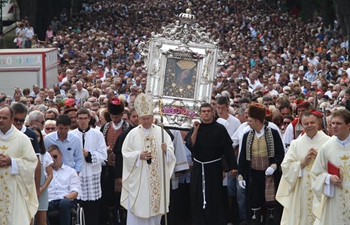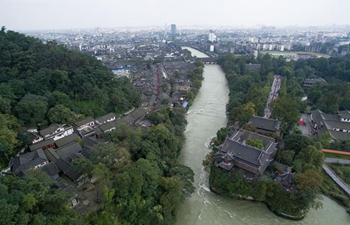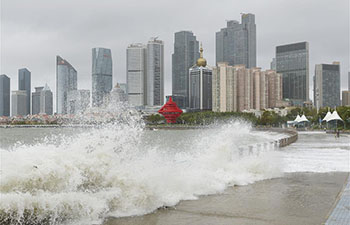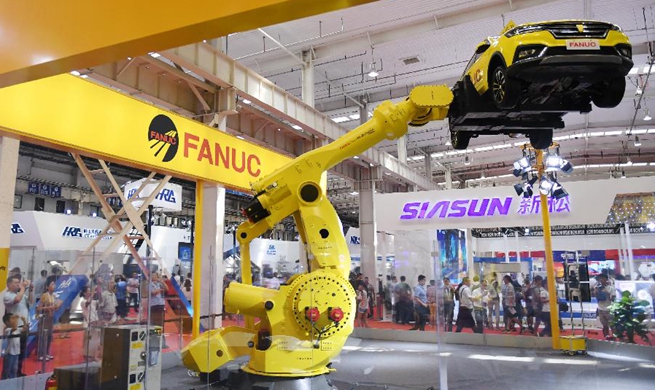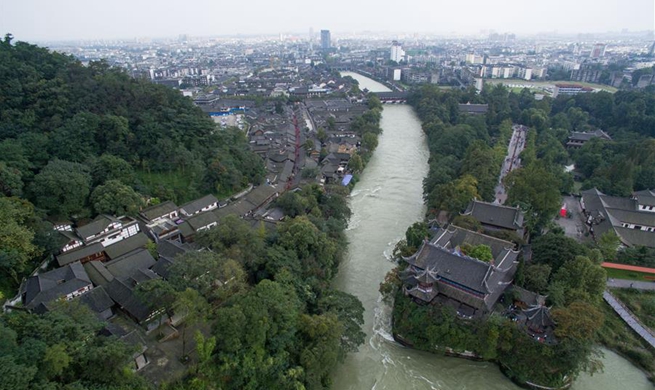ROME, Aug. 15 (Xinhua) -- As rescuers dug for survivors in the debris on Wednesday after a highway bridge collapsed in the northwestern Italian city of Genoa, killing dozens, the government was quick to blame the highway operator for putting profit before maintenance.
However, some experts opined that the disaster had likely been in the making for decades, and no amount of maintenance could cure an obsolete piece of infrastructure that was being loaded with far more traffic than it was meant to bear.
The much-traveled viaduct built in the 1960s, is part of a toll highway linking the port city of Genoa to southern France. It was collapsed during a torrential downpour shortly before noon on Tuesday, sending several cars and trucks crashing onto a railway, a riverbed and a couple of warehouses that lay 45 metres below.
"The bridge was being used under very different conditions from those it was conceived for," urbanist Alessandro Bianchi, a former student of the civil engineer Riccardo Morandi who designed the bridge that took his name, told RAI public broadcaster.
The Morandi Bridge, which locals had nicknamed the Brooklyn Bridge, was held up by cable stays in iron and prestressed concrete -- a material which, according to Bianchi, "does not work well under traction".
In addition, "traffic went from a few million cars to 20 million crossings (a year)," he said. "It is possible the sudden collapse was caused by years of increasing stress" to the bridge.
Nine years ago its private operator, Autostrade per l'Italia, argued for the construction of a slip road to relieve congestion on the bridge.
"Every year, 25.5 million vehicles cross the viaduct, where traffic has quadruplicated in the past 30 years and is destined to grow by 30 percent in the next 30 years," the highway operator wrote in a 2009 proposal to city authorities.
The proposal was nixed at the time under strong local opposition led by the populist Five Star Movement, which is now in the governing coalition and whose ministers are calling for the management of Autostrade to resign and for the company to be punished with multi-million euro fines.
Architect Diego Zoppi, who is the chief of Italy's National Architecture Association, agreed with Bianchi that stays in reinforced concrete are not ideal in conditions of constantly increasing traffic.
"What perhaps turned out to be lethal was the combination (of the construction material) with the wear-and-tear -- the myriad inputs over time that loaded and fatigued the structure," Zoppi told RAI.
Italy is no stranger to fatal bridge and viaduct collapses. In March 2017, a highway bridge collapsed during maintenance work in the central Marche region, claiming two lives.
In October 2016, a viaduct in the northern Lombardy region gave way at the passage of a heavy truck, crushing to death a motorist on the highway below. In October 2013, two people died while crossing a bridge that fell apart during torrential rains in the Sardinia island region, where a month later, another viaduct collapse killed a police officer.
Perhaps the most resounding infrastructure failure, however, was the 2014 collapse of a viaduct spanning a state road linking the Sicilian cities of Palermo and Agrigento: while there were no fatalities, what stands out is the short life span of the bridge, which was inaugurated just before Christmas and buckled soon after New Year.
